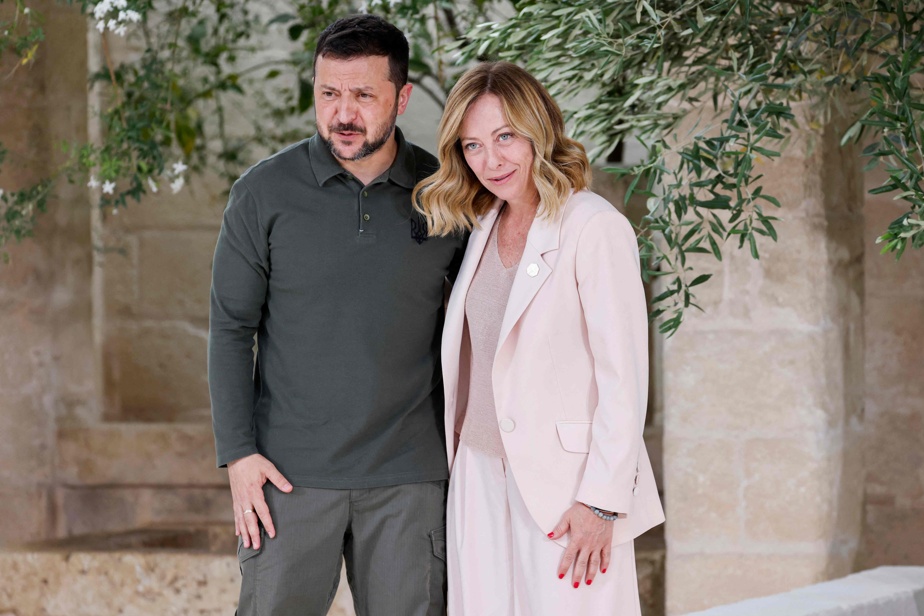(Bari) G7 leaders welcomed Volodymyr Zelensky to Italy on Thursday, announcing a $50 billion loan and an agreement to use frozen Russian assets to help Kyiv defend itself, proving, according to the US president, that the West “is not backing down” in the face of Vladimir Putin.
“We have reached a political agreement to provide additional financial support to Ukraine of around $50 billion by the end of the year,” said the head of the Italian government, Giorgia Meloni, whose country ensures this year the rotating presidency of the G7.
This agreement shows Russian President Vladimir Putin that we are “not going backwards,” said US President Joe Biden.
This breakthrough at the G7 and the bilateral security agreement between Kyiv and Washington the same day on the sidelines of this summit “demonstrate to Putin that he will not wear us down, that he cannot divide us,” he said. underlined Mr. Biden during a press conference with his Ukrainian counterpart.
Mr. Zelensky joined the heads of state and government of the “Group of 7” (United States, Germany, France, Italy, United Kingdom, Canada, Japan) in Borgo Egnazia, near Bari, in the south of Italy.
Joe Biden, Olaf Scholz, Emmanuel Macron and their counterparts met in this luxurious seaside resort to discuss new aid and a financial support mechanism allowing Russian assets to grow for the benefit of Ukraine. frozen by Westerners.
Olaf Scholz hailed a “historic” deal.
“It is right that Russia pays,” responded Mr. Zelensky at the “Group of 7” table, demanding the outright confiscation of the 300 billion euros in assets of the Russian central bank frozen by the EU and the G7, which the latter refuse for legal reasons.
Faced with the prospect of a return to the White House of Donald Trump and the uncertainty surrounding the consequences of his election for Ukraine, the G7 countries, which include Ukraine’s main military and financial supporters since the Russian invasion of February 2022, want to secure funding for this aid.
At the initiative of the United States, they therefore approved the principle of a $50 billion loan for Kyiv, guaranteed by future interest generated by immobilized Russian assets.
“This is a solidarity loan” of which the share assumed by each country is not yet known, a senior White House official explained on Thursday.
Volodymyr Zelensky also signed two ten-year bilateral security agreements on Thursday, one with Washington, the other with Tokyo.
The United States also announced on Wednesday a new round of sanctions aimed at curbing the Russian war effort, targeting entities located in Russia and countries including China, Turkey and the United Arab Emirates.
President Volodymyr Zelensky, however, assured that he had received assurances from his Chinese counterpart Xi Jinping that Beijing would not sell arms to Russia.
“I had a telephone conversation with the leader of China. He said he would not sell weapons to Russia. We’ll see,” he said. “He gave me his word.”
Mr. Zelensky thanked his allies for this aid while calling on them to “accelerate” their deliveries of weapons and ammunition.
“We are still looking for additional Patriot [air defense systems],” he recalled.
“I also ask you to do everything possible to accelerate our transition to the [American fighter] F-16, which means accelerating pilot training,” he said.
NATO admitted on Thursday that it was struggling to find new air defense systems to deliver to Kyiv.
“I have no announcement to make on the Patriot batteries today” Thursday, admitted American Defense Secretary Lloyd Austin on the sidelines of a meeting in Brussels with his counterparts from the Atlantic Alliance.
Volodymyr Zelensky will then travel to Switzerland for a “Ukraine Peace Conference” that will bring together more than 90 countries and organizations on Saturday and Sunday, but neither Russia nor China.
Finally, the US president accused Hamas of being “the main obstacle at this stage” to an agreement on a truce with Israel and the release of hostages.
“I submitted a proposal approved by the Security Council, by the G7, by the Israelis, and the main obstacle at this point is Hamas refusing to sign, even though they proposed something similar,” he said. he declared.
As the conflict between Israel and the Palestinian Islamist movement Hamas entered its 9th month, US Secretary of State Antony Blinken made yet another tour of the Middle East to try to salvage the ceasefire plan announced on May 31 by Joe Biden.
Mr. Blinken deemed certain changes requested by Hamas “unworkable.”




